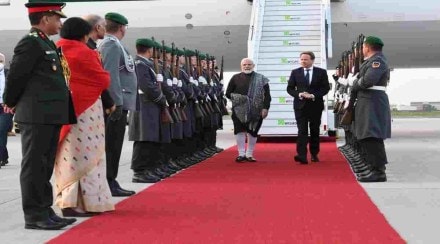At a time Russia’s war with Ukraine is impacting Europe’s economy and the rest of the world, PM Narendra Modi’s visit to Germany, Denmark and France attempts to reset India’s ties with the Continent. India has nuanced its neutral stance on the war by drawing attention to its humanitarian consequences, stating that there are no winners in this conflict as all will suffer. Whether this shift soothed the frayed nerves in Europe is a different matter. Europe’s growth is much weaker than expected, with the GDP of 19 eurozone nations expanding by only 0.2% in the first quarter of 2022 while facing higher energy and food prices.
Europe is making painful adjustments to reduce its dependence on Russian energy supplies—with a total ban on oil by the year-end—and shifting towards greater reliance on clean energy over the medium-term. India, too, seeks to enhance its energy security by ramping up capacities for renewable energy, and seeks technology and development assistance from European countries. Europe, in turn, seeks to deepen its political and economic engagement with fast-growing India, the world’s largest democracy. European Union president Ursula von der Leyen recently visited Delhi and agreed to launch the EU-India Trade and Technology Council for closer cooperation on emerging technologies, including working towards a free trade agreement with India as part of an outreach towards the Indo-Pacific region.
Modi’s visit to Berlin, Copenhagen and Paris sought to “energise” bilateral relations with European majors, Germany and France, besides attending the India-Nordic summit. Germany has the biggest dependence on Russian oil and gas (like India with Russian defence equipment), and has been under pressure to reduce it. It has now decided to stop import of Russian coal this summer and severely reduce gas imports. Although the country is one of the bright spots in Europe’s economic performance, an immediate ban on Russian gas will plunge it into a deep recession besides triggering a surge in energy prices. Shifting to clean energy is very much part of its agenda.
The most substantive outcome of the 6th India-Germany inter-governmental consultations, co-chaired by Modi and chancellor Olaf Scholz, was the declaration of intent on a bilateral partnership on green and sustainable development, with development assistance of 10 billion euros by 2030 to support India’s green growth plans. Both nations have agreed to create a green hydrogen taskforce and a partnership on renewables. They also agreed to work on joint projects in third countries. There is also a comprehensive partnership on migration and mobility to ease movement of skilled Indian workers, which could serve to facilitate the larger FTA between EU and India. Germany has also invited India to attend a summit of the G-7 in June. In Copenhagen, both India and Denmark resolved to take forward their green strategic partnership. The summit with Nordic countries—Sweden, Finland, Norway, Denmark and Iceland—was also energy-related as they are pioneers in clean energy, green technologies and innovation. India sought their investments in the blue economy sector, for the sustainable development of its marine resources.
The last leg of PM Modi’s three nation trip was to meet France’s re-elected president Emmanuel Macron. As with Germany, India has a strategic partnership with France, which it seeks to bolster through cooperation in co-developing, co-designing and co-manufacturing defence equipment. Both countries had launched the International Solar Alliance during COP 21 and renewed their commitment to partner more strongly on environment-friendly technologies and ramp up their joint commitments in the Indo-Pacific region. With this visit, PM Modi has signaled that Europe is an important part of India’s strategic calculus.
